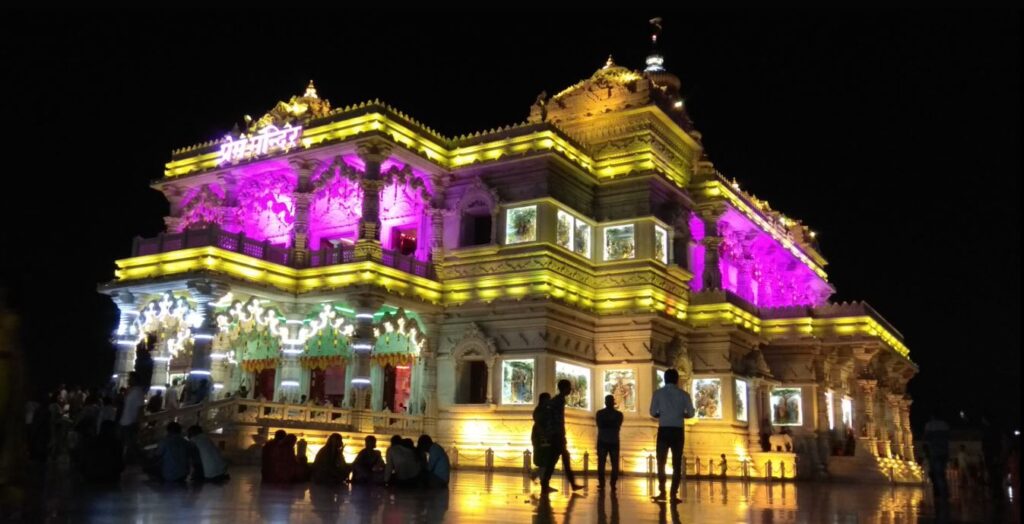Vrindavan Temple: Introduction – Vrindavan Temple, nestled in the sacred town of Vrindavan in Uttar Pradesh, India, stands as a beacon of devotion and architectural brilliance. This temple holds profound significance in Hindu mythology, drawing pilgrims and tourists from around the world.
Vrindavan Temple: Introduction / Vrindavan Temple: Introduction
History and Significance

Early History
The roots of Vrindavan Temple date back centuries, tracing its origins to the ancient times of Hindu mythology. It is believed to have been established by the followers of the Vaishnava saint, Chaitanya Mahaprabhu, in the 16th century.
Connection to Hindu Mythology
Vrindavan is revered as the sacred land where Lord Krishna spent his childhood and performed divine pastimes. The temple holds a special place in the hearts of devotees, symbolizing the eternal love between Lord Krishna and Radha.
Renovation and Expansion
Over the years, the temple has undergone several renovations and expansions to accommodate the growing number of devotees. Various dynasties and rulers have contributed to its grandeur, resulting in a splendid architectural marvel.
Architecture and Design
Structural Layout
The temple complex boasts intricate architecture, characterized by ornate carvings, domes, and spires. The main sanctum, adorned with intricate sculptures and paintings, houses the divine idols of Radha and Krishna.
Sacred Elements
Every corner of the temple is adorned with sacred symbols and motifs, invoking a sense of divine presence. The holy river Yamuna flows nearby, adding to the spiritual aura of the surroundings.
Art and Sculptures
The temple is adorned with exquisite artwork depicting scenes from Hindu mythology. Intricately carved sculptures and frescoes narrate the divine stories of Radha and Krishna, captivating the hearts of visitors.
Religious Practices and Festivals
Daily Rituals
The temple reverberates with the melodious chants of hymns and prayers, as devotees gather to offer their respects to the deities. Daily rituals including aarti, bhajans, and prasad distribution are conducted with utmost devotion.
Major Festivals Celebrated
Vrindavan Temple comes alive during festivals Janmashtami ,Radha Ashtami, when devotees throng in large numbers to partake in the celebrations. The air is filled with joyous festivities, devotional music, and spiritual fervor.
Pilgrimage Experience
Spiritual Ambiance
Visiting Vrindavan Temple offers a transformative experience, as pilgrims immerse themselves in the divine atmosphere of devotion and spirituality. The serene surroundings and the divine presence of Radha and Krishna create an aura of peace and tranquility.
Visitor Amenities
The temple provides various amenities for the convenience of visitors, including accommodation facilities, dining halls offering prasad, and guided tours to explore the sacred precincts.
Community and Social Impact
Support to Local Economy
The presence of Vrindavan Temple has a significant impact on the local economy, providing employment opportunities and fostering economic growth through tourism and associated businesses.
Role in Cultural Preservation
The temple plays a pivotal role in preserving and promoting the rich cultural heritage of India, showcasing the architectural brilliance and spiritual traditions of Hinduism to the world.
Challenges and Preservation Efforts
Conservation Initiatives
Efforts are underway to conserve and restore the architectural heritage of Vrindavan Temple, ensuring its longevity for future generations. Conservation projects focus on preserving the structural integrity and artistic treasures of the temple.
Management of Crowds and Waste
Managing the influx of pilgrims and tourists poses challenges in maintaining cleanliness and orderliness in and around the temple premises. Initiatives for waste management and crowd control are being implemented to address these concerns.
Spiritual Significance Beyond Hinduism
Influence on Spirituality Seekers
Vrindavan Temple serves as a spiritual magnet, attracting seekers from diverse cultural backgrounds who seek solace and enlightenment in its sacred environs. The universal message of love and devotion transcends religious boundaries, touching the hearts of all who visit.
Global Recognition
The spiritual resonance of Vrindavan Temple has earned it global recognition as a symbol of India’s spiritual heritage. It stands as a testament to the enduring legacy of Hinduism and its profound impact on world spirituality.
Conclusion
Vrindavan Temple stands as a timeless monument of faith and devotion, embodying the eternal love between Radha and Krishna. Its rich history, magnificent architecture, and vibrant spirituality continue to inspire and uplift millions of souls worldwide.
Unique FAQs
- How old is Vrindavan Temple?
- Vrindavan Temple traces its origins back to the 16th century, making it several hundred years old.
- What is the significance of Janmashtami at Vrindavan Temple?
- Janmashtami, the birth anniversary of Lord Krishna, is celebrated with great fervor at Vrindavan Temple, drawing devotees from far and wide to partake in the festivities.
- Are there any restrictions for visitors at Vrindavan Temple?
- While visitors are welcome to explore the temple premises, certain areas may have restricted access during religious ceremonies ,renovation work.
- How can one contribute to the preservation efforts of Vrindavan Temple?
- Donations towards conservation projects and volunteering for cleanliness drives are some ways individuals can contribute to the preservation of Vrindavan Temple.
- Is photography allowed inside the temple complex?
- Photography guidelines may vary, generally, photography for personal use is permitted in designated areas while maintaining respect for the sanctity of the temple.




Pingback: Mental Health Tips - Realone
Pingback: Wikipedia: Unraveling the World's Collective Knowledge - Realone
Pingback: Exploring the Power of Google Assistant - Realone